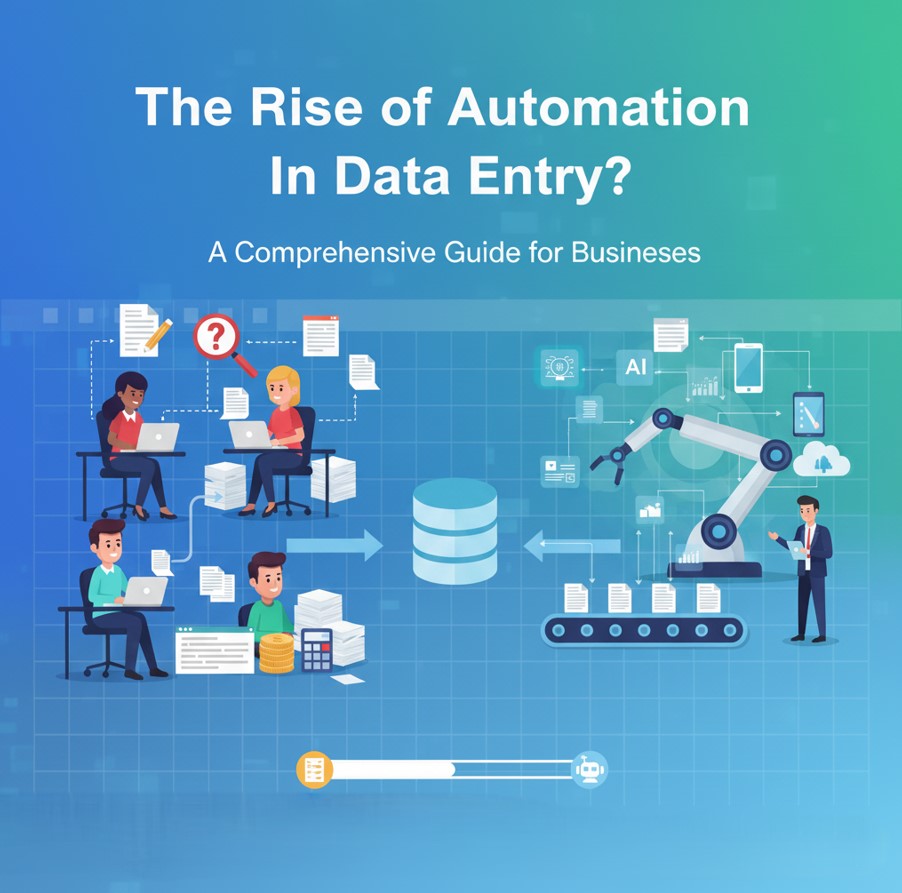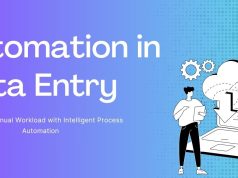For many years, manual data entry has formed the backbone of most businesses, making sure information moves fluidly across processes, systems, and departments. But as businesses expand, so does the volume and complexity of data, and human data entry turns into a tiresome and fallible task.
Enter automation. Putting your data entry process on automation is possible, and you can achieve it with the advances in technology, as it will help you not only save time but also costs and eliminate human errors. But is data entry automation the solution for all businesses? And how does it really work?
In this blog post, we will focus on how we can automate data entry, the tools and technologies that make it possible, and how businesses can implement it effectively.
Understanding Data Entry

What Does Data Entry Entail?
Data entry refers to the process of inputting, updating, or transferring data into digital formats. It encompasses a wide range of tasks, including:
- Manually entering records from physical documents into digital databases.
- Updating customer information in CRM systems.
- Generating invoices, orders, and reports based on collected data.
- Data transcription from one software system to another.
While data entry is essential for operations, its manual execution can be tedious, susceptible to mistakes, and inefficient in today’s fast-paced, data-driven world.
Challenges of Manual Data Entry
Manual data entry comes with its fair share of challenges, including:
- Human Errors: Typos, miscalculations, or skipped entries can have costly consequences for businesses.
- Time-Consuming: Processing large volumes of data requires significant labor and time.
- Repetitive and Tedious: The monotonous nature of manual data entry leads to employee burnout and low satisfaction.
- Scalability Issues: A growing business may struggle to handle increasing data demands without significant manpower investment.
These inefficiencies set the stage for automation to come to the rescue.
The Rise of Automation in Data Entry
Automation is the use of technology to perform tasks with minimal human involvement. Automation, when applied to data entry, can revolutionize the way businesses handle their data.

The Benefits of Automating Data Entry
- Improved Accuracy
Automation tools are designed to eradicate human inaccuracies, guaranteeing that the information input is accurate and coherent.
- Time and Cost Savings
By automating repetitive tasks, employees have the time and desire to focus on higher-value functions, helping to both decrease labor costs and increase productivity.
- Scalability
With Automation, businesses can execute processes on a large scale, eliminating the eventuality to hire more professionals.
- Data Security
Most such automation is equipped with integrated encryption and data protection regulation compliance.
- Real-Time Updates
Most such automation is equipped with integrated encryption and data protection regulation compliance
Tools and Technologies for Data Entry Automation
To automate data entry processes across a lot of technology solutions. These can be quite different in capabilities, costs, and complexity to implement. Here are some of the most common technologies in the field of data entry automation.
Optical Character Recognition (OCR)
OCR software (optical character recognition) is a software tool that extracts text from images or scanned files. It is particularly useful for digitizing invoices, receipts, and handwritten forms. These kinds of tools may include ABBYY FineReader, Tesseract OCR, etc.
Automated Data Platforms
Cloud-based tools like Zapier and Airtable enable automation by connecting multiple software systems. They allow businesses to automate workflows such as transferring data between apps or syncing databases.
Robotic Process Automation (RPA)
RPA uses bots to replicate human interactions within applications. Tools like UiPath and Blue Prism are popular choices for automating repetitive tasks such as bulk data entry.
AI and Machine Learning
AI-driven platforms such as Hyper Science and Monkey Learn go beyond basic automation, enabling intelligent data extraction, analysis, and decision-making processes.
Dedicated Data Entry Software
Platforms like DocuWare and Kofax combine multiple automation technologies to handle end-to-end data processing tasks.
Implementing Automation for Data Entry
The success of data entry automation lies in careful planning and execution. Here’s a step-by-step guide to help your business automate its data entry processes.

Step 1: Assess Your Needs
Identify the specific pain points and inefficiencies in your current data entry processes. Evaluate which tasks consume the most time or are prone to errors.
Step 2: Choose the Right Tool
Research and compare automation tools that suit your requirements. Look for scalability, ease of integration, and cost-efficiency.
Step 3: Test and Pilot
Before a full-scale implementation, test the automation tool with a pilot project. Identify and iron out any challenges during this phase.
Step 4: Train Your Team
Provide proper training to your employees on how to use the chosen automation tools. Ensure they understand the process and are equipped to troubleshoot any issues.
Step 5: Monitor and Optimize
Regularly monitor the performance of your automated systems. Gather feedback and make adjustments to optimize the process further.
Real-Life Examples of Successful Data Entry Automation
Case Study 1: A Retail Company Reduces Invoice Processing Time
A mid-sized retail company implemented OCR software for processing invoices. By automating the extraction of invoice details, the company reduced manual processing time by 80% and achieved 99.9% data accuracy.
Case Study 2: Hospital Streamlines Patient Records Management
A hospital used RPA tools to automate the entry of patient information into its electronic medical records (EMR) system. This reduced administrative workload by 35%, allowing healthcare staff to focus more on patient care.
Case Study 3: Small Business Achieves Cost Efficiency
A small e-commerce business adopted Zapier to automate order tracking and inventory updates. The integration saved hours of manual input work while significantly lowering human errors.
Navigating Challenges in Data Entry Automation
Although automation brings immense benefits, businesses may encounter challenges during implementation. Here’s how to address them.
Challenge 1: Integration Complexity
Some legacy software systems may not be compatible with modern automation tools.
- Solution: Work with vendors that provide customized integration solutions or consider upgrading legacy systems where possible.
Challenge 2: High Initial Investment
While automation reduces costs in the long run, the upfront investment can be intimidating.
- Solution: Start small with affordable tools or pilot programs to demonstrate ROI before scaling up.
Challenge 3: Employee Resistance
Employees may worry about job displacement due to automation.
- Solution: Communicate openly about automation’s role in enhancing their efficiency and provide training for higher-value responsibilities.
The Future of Data Entry Automation
Data entry automation will continue to evolve, with artificial intelligence and machine learning playing increasingly critical roles.
- Intelligent algorithms will predict patterns in data, making processes smarter and faster.
- Voice recognition and real-time transcription tools will offer new ways to digitize data.
- Industry-specific automation tools will emerge, designed to address unique challenges in sectors like healthcare, finance, and retail.
Businesses that adapt now will not only gain a competitive advantage but also be better prepared for the innovations of tomorrow.
Streamline Data Entry for Better Business Efficiency
The question is not whether data entry can be automated; it’s when your business will take the plunge. Automation provides a straightforward way to cut costs while increasing productivity and improving operational accuracy. When implemented correctly, these tools and strategies can help organizations free up time and resources to reinvest in strategic growth.
Want to learn more about the tools above, or get started? Things To Consider: Start looking for RPA tools, OCR tools, and AI tools, and how you can start automating processes immediately.










